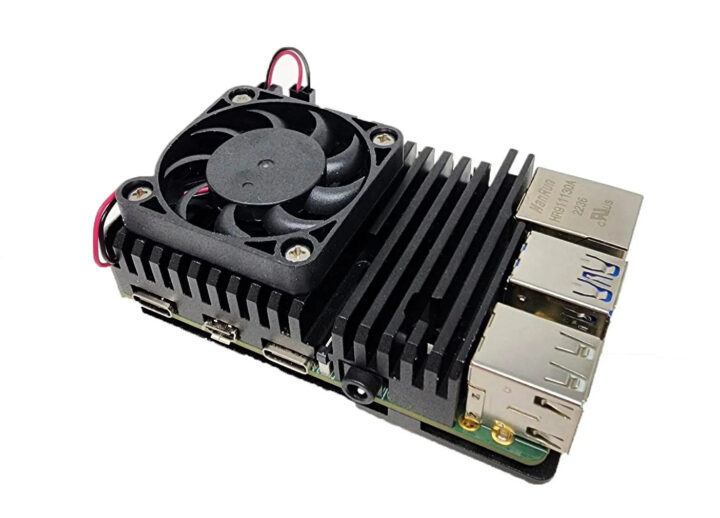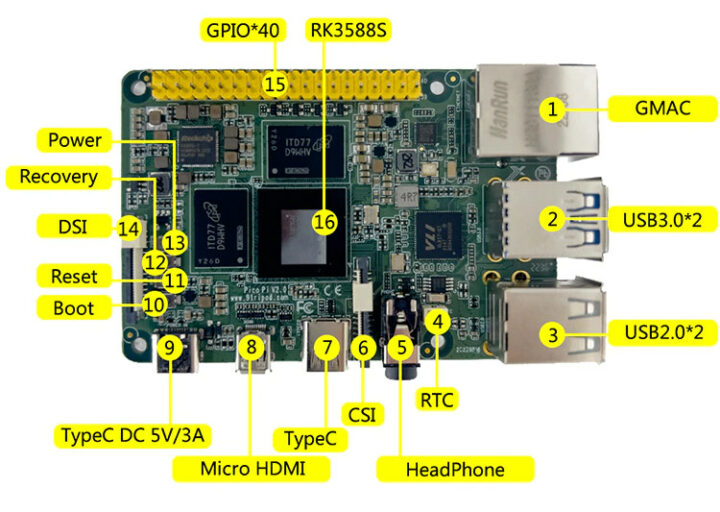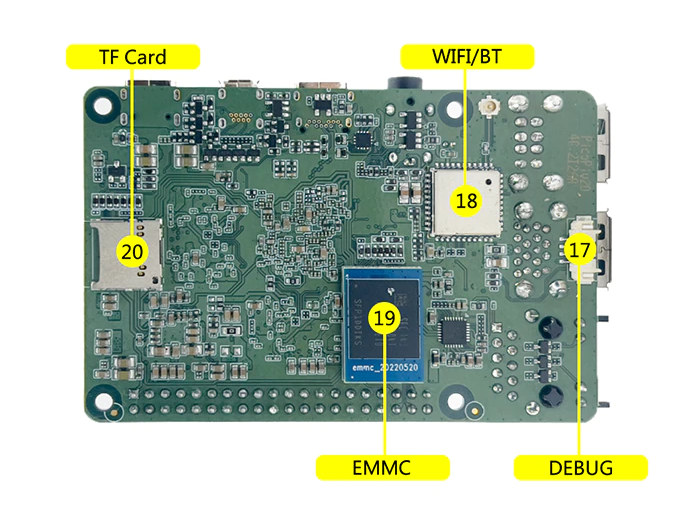Indiedroid Nova is another Rockchip RK3588S SBC with Raspberry Pi 4 form factor, up to 16GB RAM, with a heatsink that serves as a protective cover, fitted with a fan (if needed), and an optional swappable flash module up to 64GB capacity.
The Nova board has basically the same port layout as the Raspberry Pi 4, except for one of the micro HDMI ports being replaced by a USB Type-C port with support for DisplayPort, so you’ll still get a Gigabit Ethernet port, WiFi 5 & Bluetooth 5.0 connectivity, two USB 3.0 ports, two USB 2.0 ports, MIPI CSI and DSI connectors, etc…

Indiedroid Nova specifications:
- SoC – Rockchip RK3588S
- CPU – Octa-core processor with 4x Cortex-A76 cores @ up to 2.2-2.4 GHz, 4x Cortex-A55 cores @ up to 1.8 GHz
- GPU – Arm Mali-G610 GPU with OpenGL ES 3.2, OpenCL 2.2, and Vulkan 1.2 support
- VPU – 8Kp60 video decoder for H.265/AVS2/VP9/H.264/AV1 codecs, 8Kp30 H.265/H.264 video encoder
- AI accelerator – 6 TOPS NPU
- System Memory – 4GB, 8GB, 16GB LPDDR4x (1GB, 2GB, and 32GB option for future variant)
- Storage
- MicroSD card socket
- Optional eMMC 5.1 flash module connector to add 8GB, 16GB, 32GB, 64GB, or 128GB storage module
- Video Output
- 1x micro HDMI 2.1 port
- DisplayPort via USB Type-C port (TBC)
- 4-lane MIPI DSI connector
- Camera I/F – MIPI CSI connector (4-lane or 2x 2-lane)
- Audio – 3.5mm earphone jack
- Networking
- Gigabit Ethernet RJ45
- Realtek RTL8821CS dual-band WiFi and Bluetooth 5.0 module
- USB – 2x USB 3.0 Type-A ports, 2x USB 2.0 Type-A ports, 1x USB Type-C port
- Expansion – 40-pin Raspberry Pi compatible GPIO header
- Debugging – 4-pin debug connector (for serial console)
- Misc
- Power, Recovery, Reset, and Boot buttons
- Power LED, user LED
- RTC battery connector
- Power Supply – 5V/3A via USB Type-C port
- Dimensions – 85 x 56mm (Raspberry Pi 4 form factor)
If all that looks familiar that’s because Ameridroid is the official distributor of the 9Tripod Pico PC V2.0 we covered a while ago, and they even copy-pasted the specs from CNX Software without attribution. So that’s the exact same board, but at the time, I only recommended it to people who feel adventurous because of the limited documentation and Chinese-only forums. The good news is that there’s now an Indiedroid website with minimal documentation and OS images for the Nova board including Ubuntu 20.04/22.04, Debian 11/12, Devuan, Armbian-built Debian/Ubuntu images, Batocera for retro-gaming, and a few others.
The distribution deal means the 9Tripod Pico PC V2.0 can not be purchased from Aliexpress anymore, and instead, Ameridroid offers bundles from $144.90 (4GB/32GB configuration) up to $224.95 (16GB/64GB) plus shipping for pre-order with 10% discount using the coupon on the store. Another very similar option is the Cool Pi 4 Model B SBC which sells for $134.67 shipped with 4GB RAM and a heatsink and fan, but no eMMC flash module, and up to $196.72 with 16GB RAM and a 64GB eMMC flash module. As discussed in previous articles, those types of boards are much faster, typically three to four times, than a Raspberry Pi 4, but are better suited to more experienced/skilled users.
Thanks to “Sgt_Sphincter” for the tip.

Jean-Luc started CNX Software in 2010 as a part-time endeavor, before quitting his job as a software engineering manager, and starting to write daily news, and reviews full time later in 2011.
Support CNX Software! Donate via cryptocurrencies, become a Patron on Patreon, or purchase goods on Amazon or Aliexpress







Why would you buy this instead of an x86 based NUC? About the same price, so … why would you prefer a naked 3588 SBC? Is it because of the interfaces?
Is there any affordable x86 units out there? What’s the cheapest ones I am curious. Very interested.
Well in this price range you could e.g. choose a Beelink S12. In the smallest configuration it has an Intel N95, 8GB RAM, a 256GB SSD and is sold for around 160$. Performance wise it might be the better deal and has more and better coastline connectors. What it doesn’t have is GPIO and MIPI CSI.
BMAX B2 Pro Mini PC (8GB, 256GB, Intel J4105, Windows 11) voor €120,76 @ Geekbuying
€120,76
Within EU, including VAT and shipping. And including EU consumer rights (2 year warranty), but good luck getting that from Geekbuying.
You could have such hardware for about $150, which is smaller and looks more like a finished product: https://www.cnx-software.com/2023/04/07/higole-pc-stick-j4125-wifi-6-review-specs-unboxing-teardown-first-boot/
Smaller size, it can run fanless (despite the included fan), integrated 6 TOPS AI accelerator, GPIO header, MIPI DSI and CSI interfaces, and 8K video support which the Intel platforms in this price range don’t seem to support.
AI accelerators are clearly coming to mobile and desktop x86, starting with Phoenix and Meteor Lake. But who knows when it would arrive in an Alder Lake-N or Mendocino sequel.
If I’m not mistaken, the iGPU in Alder Lake-N should support 8K decode, even though the SoC can only output at 4K. Because it’s using some form of Xe/Gen12 graphics (but there are slight variations like Tiger Lake retaining VP8 decode and others dropping it).
I just got a refurb HP mini PC with intel 6500, ssd, 16gb RAM and a windows pro license .. For $117!
Then again, that processor pulls 65W. Think SBC is a bit of a different use case. Should be, because otherwise I agree…
eMMC modules are vastly more expensive than M.2 and so this particular aspect makes is less of a proposition than the Orange Pi 5 or NanoPi R6S.
Whilst the inclusion of WiFi/BT is good, the use of eMMC just devalues its appeal for me.
I have to agree. As nice as eMMC modules were to have when the only other options were USB or uSD, we’re part that time. M.2 in either SATA or NVME are way better and much more flexable. PCI-E on M.2 offers the ability to add a variety of I/O, not just very fast storage.
eMMC needs to start being seen as a lower end option and not as a feature–more of a limitation vs M.2 capable boards. Even 1 PCI-E v2 lane beats all eMMC.
I tend to really like boards with eMMC storage (not necessarily eMMC module, but soldered on the board) mostly because they usually work out of the box and performance is good enough. M.2 SSDs are typically faster but that usually means the board designer needs to “sacrifice” one of the interfaces to add the feature.
> the board designer needs to “sacrifice” one of the interfaces to add the feature.
Which is especially an issue with boards that rely on castrated SoCs like here. Most people seem to overlook that RK3588S features only two Gen2 PCIe lanes in total, both multiplexed with SATA, one also with USB3.
Adding to this driver issues preventing SSDs to enter low-power modes…
eMMC uses up an SDHC/SDIO controller which would be used for wireless or other purpose, so they’re not without ‘sacrifice’ on these pin limited SoCs. The number of devices that can connect to the SoC with their limited number of high speed SERDES lines is more a product of the cost of the chip and the power budget of the system. More high speed lines means more power use. So, it’s a matter of deciding what they are best used for. Conversely, they powersave very well, so if you have more SERDES than you end up using in an application,… Read more »
> eMMC uses up an SDHC/SDIO controller
…which usually is available exclusive while at least with Amlogic and recent Rockchip SoCs PCIe is always pinmuxed with USB3/SATA.
Funnily on this board here Wi-Fi/BT is connected via SDIO 3.0, obviously one of the two PCIe lanes has been ‘sacrificed’ for USB3 (USB3-A receptacles behind a VL817 USB hub) though no idea what happened to the other PCIe lane…
> Even 1 PCI-E v2 lane beats all eMMC.
When looking at (mostly irrelevant) sequential transfer speeds and ignoring consumption issues (stuff like this).
We’ve already seen garbage SSDs showing lower random I/O performance than quality eMMC modules (same with sustained sequential transfer speeds) and the issue of counterfeit flash memory products is way more present with el cheapo SSDs than (soldered) eMMC.
I said that PCI-E beat all eMMC, not that any junk drive people chose to use would be better. But you have the option to use something better. You can get a junk drive with any interface, the interface of the drive doesn’t determine its performance beyond *limiting* it to what it can handle. In that sense PCI-E beats eMMC. Yes, you can get a crap drive with either interface, but that’s not the fault of the interface. There are plenty of crap eMMC drives out there as well. I note that you separate out *soldered eMMC* drives from eMMC… Read more »
> you have the option to use something better.
Sure but consumers will choose ‘cheap’ instead (they’re trained to look at irrelevant metrics anyway) and vast majority of 2230/2242/2260 NVMe SSDs is garbage since almost none of the reputable vendors do SSDs that short.
Also majority of consumers has no idea about f3probe/h2testw to check for counterfeit flash products.
I guess I got lucky then as I picked up some OEM Samsung drives in 2242 from Lenovo laptops. They have the same performance as the full size 2280 boards of that model line.
I’ve also noticed that there are more drives with good performance in this size range. The 2242 is popular in ultrabooks and the 3060 is used in the Steam Deck.
Hey, look at that: https://www.anandtech.com/show/18831/corsair-launches-mp600-mini-m2-2230-ssd-brings-big-performance
Thanks for covering this! Using the included coupon (on the site’s page), the starting price is around USD $130, and these are shipping now.
BTW, if you find any non-attributed information on the site, let us know and we’ll resolve that immediately.